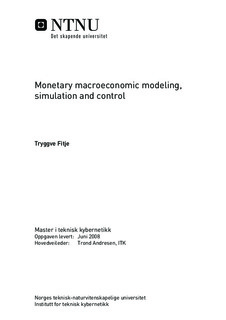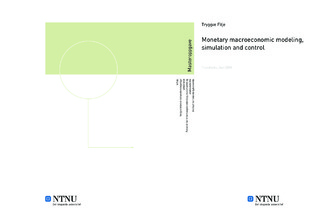| dc.description.abstract | In this report a dynamic macroeconomic model is built in an incremental manner. The economic units are built on an understandable tank analogy that can be described with the use of first order differential equations. The units are realised in the form of block diagrams in Mathworks Simulink®. Simulink block diagrams gives an explicit mathematical formulation of the model, thereby making all the equations, the model consists of, readily available. The economy s ability to service debt in different settings is tested. The first part of this model is kept simple, so as to make it understandable to people with different backgrounds. Then model realism gets increased priority, but still it is considered vital for the usefulness of the model that the reader truly understands it. However, the fundamental point of the thesis is made before model complexity should become an issue. The foundation for the thesis, which is the work of Trond Andresen is represented in an oral manner, with simple mathematics at the base. The model is built by adding new elements to the model throughout the report, giving an understanding of the individual parts of the model, before they are merged together and the complexity increase. A system that models economic mood is implemented, which has an amplifying effect on the current trend in the economy, and adds new dynamics because of its lag to the actual state of the economy. Real economy deposits are implemented as a counterweight to the financial sectors loan issuing. Insolvency in both the real economy and the financial sector is implemented. They both make up balancing loops, setting limits on real economy earnings on deposits, as well as bank s earnings on issued loans. They both also prevent the model from displaying impossible dynamics under extreme conditions. Banks lending is limited by capital requirement, set by the bank of international settlements, BIS. An regulating agent is also implemented, to guide the economy and keep it on track. It imposes a reserve requirement on the financial sector, which it makes the bank sector uphold through open market operations. Finally a stock market with innate oscillations , developed by Trond Andresen, is implemented in the model. It is not connected to the economy via vessel dynamics, rather it influence the economy through the implemented mood system. This makes the economy more less robust, and induces oscillations in to the economy in otherwise static settings. The economy appear as very fragile, just minor variations in interest rates makes for large fluctuations in the debt burden. The model exhibits path dependence. Minor changes in parameters makes the economy lock into states from which it does not recover. Modelling dynamic systems, especially nontechnical is an imperfect try and fail science. The model will always contain flaws and shortcomings. The best we can do is try to minimize the flaws in the elements that are important for answering the questions we want answered. | nb_NO |

